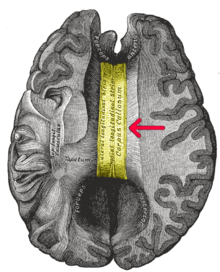This article needs additional citations for verification. (December 2016) |

A corpus callosotomy (/kəˈlɔːs(ə)təmiː/) is a palliative surgical procedure for the treatment of medically refractory epilepsy.[1] The procedure was first performed in 1940 by William P. van Wagenen.[2] In this procedure, the corpus callosum is cut through, in an effort to limit the spread of epileptic activity between the two halves of the brain.[1] Another method to treat epilepsy is vagus nerve stimulation.[3]
Although the corpus callosum is the largest white matter tract connecting the hemispheres, some limited interhemispheric communication is still possible via the anterior and posterior commissures.[4] After the operation, however, the brain often struggles to send messages between hemispheres, which can lead to side effects such as speech irregularities, disconnection syndrome, and alien hand syndrome.
- ^ a b Mathews, Marlon S.; Linskey, Mark E.; Binder, Devin K. (29 February 2008). "William P. van Wagenen and the first corpus callosotomies for epilepsy". Journal of Neurosurgery. 108 (3): 608–613. doi:10.3171/JNS/2008/108/3/0608. ISSN 0022-3085. PMID 18312112. S2CID 6007475.
- ^ Cite error: The named reference
Mathewswas invoked but never defined (see the help page). - ^ Cite error: The named reference
Abd-El-Barrwas invoked but never defined (see the help page). - ^ Gazzaniga, M. S. (1 July 2000). "Cerebral specialization and interhemispheric communication: Does the corpus callosum enable the human condition?". Brain. 123 (7): 1293–1326. doi:10.1093/brain/123.7.1293.